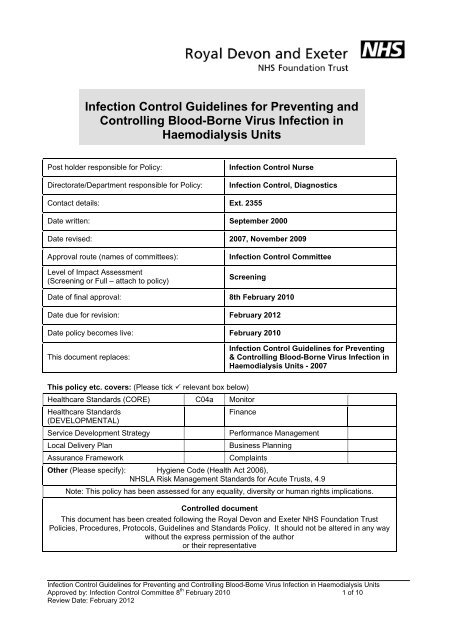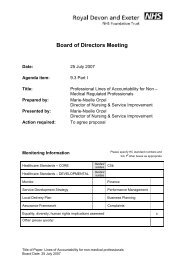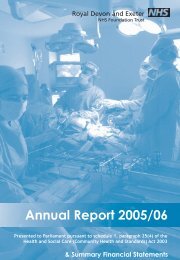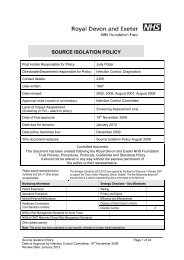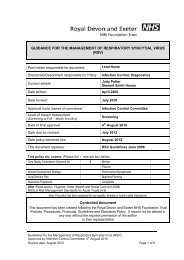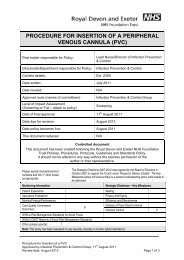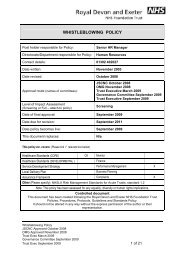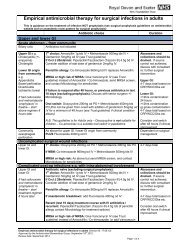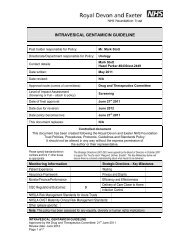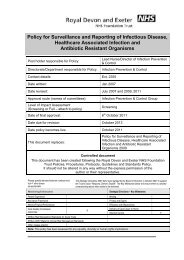infection control guidelines for haemodialysis - Royal Devon ...
infection control guidelines for haemodialysis - Royal Devon ...
infection control guidelines for haemodialysis - Royal Devon ...
You also want an ePaper? Increase the reach of your titles
YUMPU automatically turns print PDFs into web optimized ePapers that Google loves.
Infection Control Guidelines <strong>for</strong> Preventing andControlling Blood-Borne Virus Infection inHaemodialysis UnitsPost holder responsible <strong>for</strong> Policy:Directorate/Department responsible <strong>for</strong> Policy:Infection Control NurseInfection Control, DiagnosticsContact details: Ext. 2355Date written: September 2000Date revised: 2007, November 2009Approval route (names of committees):Level of Impact Assessment(Screening or Full – attach to policy)Infection Control CommitteeScreeningDate of final approval: 8th February 2010Date due <strong>for</strong> revision: February 2012Date policy becomes live: February 2010This document replaces:Infection Control Guidelines <strong>for</strong> Preventing& Controlling Blood-Borne Virus Infection inHaemodialysis Units - 2007This policy etc. covers: (Please tick relevant box below)Healthcare Standards (CORE) C04a MonitorHealthcare Standards(DEVELOPMENTAL)Service Development StrategyLocal Delivery PlanAssurance FrameworkFinancePer<strong>for</strong>mance ManagementBusiness PlanningComplaintsOther (Please specify): Hygiene Code (Health Act 2006),NHSLA Risk Management Standards <strong>for</strong> Acute Trusts, 4.9Note: This policy has been assessed <strong>for</strong> any equality, diversity or human rights implications.Controlled documentThis document has been created following the <strong>Royal</strong> <strong>Devon</strong> and Exeter NHS Foundation TrustPolicies, Procedures, Protocols, Guidelines and Standards Policy. It should not be altered in any waywithout the express permission of the authoror their representativeInfection Control Guidelines <strong>for</strong> Preventing and Controlling Blood-Borne Virus Infection in Haemodialysis UnitsApproved by: Infection Control Committee 8 th February 2010 1 of 10Review Date: February 2012
CONTENTSSectionPage1 Introduction 32 General In<strong>for</strong>mation 33 Transmission 44 Incubation Period 45 Testing <strong>for</strong> BBV 46 Immunisation of Patients against HBV 57 Multi-use vials 58 Standard Infection Control Precautions 59 Personal Protective Equipment 510 Decontamination 511 Management of Patients with known BBV andPatients of unknown status612 Isolation 713 Staff Health 714 References 8Appendix 1 9Appendix 2 10Infection Control Guidelines <strong>for</strong> Preventing and Controlling Blood-Borne Virus Infection in Haemodialysis UnitsApproved by: Infection Control Committee 8 th February 2010 2 of 10Review Date: February 2012
1. IntroductionBlood-borne viruses are, following a number of documented outbreaks, a recognisedhazard <strong>for</strong> dialysis patients and staff. The viruses that present an <strong>infection</strong> hazard inrenal units include hepatitis B (HBV), hepatitis C (HCV) and human immunodeficiencyvirus (HIV). The aim of the guidance is to prevent the transmission of blood-borneviruses within renal <strong>haemodialysis</strong> units; these may also apply to other units where<strong>haemodialysis</strong> is undertaken. These <strong>guidelines</strong> are based on the Department of HealthGood Practice Guidelines <strong>for</strong> Renal Dialysis/Transplantation Units (2002).2. General In<strong>for</strong>mation2.1 HBV is caused by a hepadnavirus. Most <strong>infection</strong>s are mild, but in a few casesresult in liver damage that may be fatal. Between 2 and 10% of those infected donot completely eliminate the virus and become chronic carriers. Virus is detectedby testing the blood <strong>for</strong> surface antigens (HBsAg). Infectivity is closely associatedwith the presence of the e-antigen (HBeAg), which indicates that active viralreplication is occurring.2.2 HCV is caused by a flavivirus. Primary <strong>infection</strong> is mild, often asymptomatic andrarely associated with jaundice. About 80% of those infected become chroniccarriers of the virus and a significant proportion develop liver disease andcirrhosis. Diagnosis relies on the detection of the specific antibody (IgG).2.3 HIV is a retrovirus. The virus contains an enzyme called ‘reverse transcriptase’two distinctive <strong>for</strong>ms of HIV have been identified: HIV-1 occurs throughout theworld, while HIV-2 has been found primarily in West Africa. HIV <strong>infection</strong> isdiagnosed by detecting viral antigens and antibodies.Infection Control Guidelines <strong>for</strong> Preventing and Controlling Blood-Borne Virus Infection in Haemodialysis UnitsApproved by: Infection Control Committee 8 th February 2010 3 of 10Review Date: February 2012
3. TransmissionBlood-borne viruses are transmitted through infected body fluids; transmission occurs byinoculation, via sharps, broken skin or through contact with mucous membranes. Therisk of transmission of BBVs following a single percutaneous exposure is estimated tobe:• HBV 1 in 3• HCV 1 in 30• HIV 1 in 3004. Incubation period4.1 HBV Between 2 and 3 months, although it may be as long as 6 months4.2 HCV Up to 3 months4.3 HIV 3 months5. Testing <strong>for</strong> BBV5.1 Patients undergoing renal dialysis should be tested <strong>for</strong> BBV as soon as it isanticipated that dialysis may be required. The patient’s in<strong>for</strong>med consent totesting must be obtained; any patients who withhold consent should be managedas though they are BBV positive. The RD&E Trust Policy regime <strong>for</strong> BBV testingis identified below;5.2 New patients or re-admissions to the dialysis program should be tested <strong>for</strong> HbsAg,HCV antibody and HIV antibody unless they have been tested in the month be<strong>for</strong>eadmission.5.3 Regular Patient testing <strong>for</strong> those receiving on-going dialysis are tested monthly <strong>for</strong>HBsAg and HCV; HIV antibody testing should be based on risk assessment.5.4 Holiday dialysis includes patients who have dialysed outside the UK and thosewho are holidaying in the UK from abroad. Consideration should be given totesting patients <strong>for</strong> HBsAg and HCV antibody. The decision to HIV test should bebased on risk assessment; undertaken by a senior member of the medical team.Infection Control Guidelines <strong>for</strong> Preventing and Controlling Blood-Borne Virus Infection in Haemodialysis UnitsApproved by: Infection Control Committee 8 th February 2010 4 of 10Review Date: February 2012
If testing is required, patients should be treated as having unknown status, untilthe results are known.6. Immunisation of Patients against HBVImmunisation against HBV is recommended <strong>for</strong> all renal dialysis patients.Patients with chronic renal failure should be immunised as soon as it is anticipatedthat dialysis may be required, guidance on the immunisation process is providedin appendix 1.7. Multi-use vialsThere is a potential <strong>for</strong> cross <strong>infection</strong> with the use of multi use vials, there<strong>for</strong>ethese should not be used.8. Standard Infection Control PrecautionsStandard <strong>infection</strong> <strong>control</strong> precautions (refer to Trust policy Standard InfectionControl Precautions), should be used in the care of all patients. Additionally, <strong>for</strong>dialysis patients other precautions need to be undertaken.9. Personal Protective EquipmentIn addition to the use of gloves and apron, eye protection (visors) is required whensplashing or aerosols of blood or body fluids are possible. Eye protection must becleaned after use by washing in liquid detergent solution, followed by thoroughdrying or using a detergent wipe.10. Decontamination10.1 In addition to the Trust decontamination policy and procedures; the cleaning ofdialysis machines will depend on the patients BBV status, each dialysis machinemust be decontaminated after individual patient use, using the following protocol;10.2 Machines should be rinse-drained.Infection Control Guidelines <strong>for</strong> Preventing and Controlling Blood-Borne Virus Infection in Haemodialysis UnitsApproved by: Infection Control Committee 8 th February 2010 5 of 10Review Date: February 2012
10.3 The outer surface of the machine should be wiped over thoroughly usingdetergent wipes.10.4 In addition once each day, the <strong>haemodialysis</strong> machines outer surface and theentire <strong>haemodialysis</strong> station (chair and table) should also be wiped overthoroughly using a disposable cloth impregnated with a chlorine releasing agent(1000ppm). Suitable products include Chlor–Clean which combines the detergentaction and chlorine releasing agent.10.5 At the end of each day all <strong>haemodialysis</strong> machines must be heat-disinfected usinginternal citrate dis<strong>infection</strong> (clean cart C). In addition all <strong>haemodialysis</strong> machinesmust be heat disinfected once a week using internal hypochlorite dis<strong>infection</strong>(clean cart A).NB clean cart C should always precede Clean cart A when per<strong>for</strong>med together10.6 Single use disposable equipment used <strong>for</strong> the dialysis machines is disposed of asclinical waste.10.7 In the event of rupture of a dialyser, the machine components that may havebecome contaminated with blood should be replaced or decontaminated by heatdis<strong>infection</strong> methods, in accordance with the manufacturers recommendations.11. Management of Patients with known BBV and Patients of unknown status11.1 In addition to standard <strong>infection</strong> <strong>control</strong> precautions, the following additionalprecautions must be undertaken <strong>for</strong> patients who are; HBsAg, HCV or HIVpositive, or have no documented evidence of a negative test in the last month (orin the last 3 months if the patient is dialysed at Taunton or Yeovil). Refer toappendix 2 <strong>for</strong> further guidance.11.2 A <strong>haemodialysis</strong> machine should be dedicated <strong>for</strong> the patient. If used on an inpatientthis should be kept in the patient’s room. Otherwise, it must be clearlyInfection Control Guidelines <strong>for</strong> Preventing and Controlling Blood-Borne Virus Infection in Haemodialysis UnitsApproved by: Infection Control Committee 8 th February 2010 6 of 10Review Date: February 2012
labelled <strong>for</strong> that patient use only and after each use be returned to the storagearea after surface and internal heat dis<strong>infection</strong> (Clean Cart C & A).Hepatitis B surface antigen (HBsAg) positive patients must always use a singlepatient dedicated machine.Hepatitis C positive (HCV) patients require a dedicated machine. Where there ismore than one hepatitis C positive patient in the same unit, the dedicated<strong>haemodialysis</strong> machine may be used <strong>for</strong> more than one hepatitis C positivepatient, subject to a risk assessment by Senior Nursing staff (Band 6 or above)and after surface and internal dis<strong>infection</strong> (run clean cart C and A – refer toappendix 2).HIV positive patient require a dedicated machine. In a units where there is morethan one HIV positive patient, the dedicated machine may be used <strong>for</strong> more thanone HIV positive patient, subject to a risk assessment by Senior Nursing staff(Band 6 or above) and after surface and internal dis<strong>infection</strong> (run clean cart C andA – refer to appendix 2).11.3 A dedicated <strong>haemodialysis</strong> machine can be returned back to general service usewhen no longer required (e.g. following transplantation, death of a patient), orrequired urgently, after surface dis<strong>infection</strong> (detergent and chlorine 1000ppm)and internal dis<strong>infection</strong> procedures have been carried out (run clean cart C andA).12. Isolation12.1 Patients with HBsAg, HCV or HIV positive result, or no documented evidence of anegative test in the last month (or in the last 3 months if the patient is dialysed atTaunton or Yeovil), should be dialysed in a single room, (refer to appendix 2 <strong>for</strong>further guidance). The room may be used <strong>for</strong> other patients after thoroughdis<strong>infection</strong> (terminal cleaning).12.2 For Patient’s HBV positive or unknown status, during dialysis restrict Staffmovement from the single room to a minimum, by allocating a dedicated nurse.Infection Control Guidelines <strong>for</strong> Preventing and Controlling Blood-Borne Virus Infection in Haemodialysis UnitsApproved by: Infection Control Committee 8 th February 2010 7 of 10Review Date: February 2012
13. Staff Health13.1 Staff taking up employment with the Trust will have their Hepatitis B immunestatus checked. Non immune staff will be immunised.13.2 Infectious carriers of hepatitis B, i.e. those who are either HBeAg (hepatitis B eantigen) positive or HBeAg negative with DNA levels exceeding 10 3 genomeequivalents per ml, should not undertake clinical duties on renal dialysis units.13.3 Such restrictions do not apply to staff having no close patient contact e.g.secretarial or laboratory staff.13.4 Routine activities undertaken by staff in renal dialysis units would not normally fallwithin the definition of exposure prone procedures. There<strong>for</strong>e staff who are HCVor HIV infected would not necessarily be excluded from working within renal units.14. ReferencesDepartment of Health (2002) Good Practice Guidelines <strong>for</strong> Renal Dialysis / Transplantation Units;Prevention and Control of Blood-borne Virus Infection.http://www.dh.gov.uk/prod_consum_dh/groups/dh_digitalassets/@dh/@en/documents/digitalasset/dh_4059511.pdfRenal Association (2009) BBV <strong>guidelines</strong>http://www.renal.org/pages/media/download_gallery/BBV<strong>infection</strong>FINAL14July09.pdfGould D & Brooker C (2008) Infection prevention and Control: applied microbiology <strong>for</strong>healthcare 2 nd edition. Palgrave Macmillan. England.Wilson J (2006) Infection Control in Clinical Practice. Bailliere Tindall. Edinburgh.Infection Control Guidelines <strong>for</strong> Preventing and Controlling Blood-Borne Virus Infection in Haemodialysis UnitsApproved by: Infection Control Committee 8 th February 2010 8 of 10Review Date: February 2012
EXETER & SATELLITE KIDNEY UNITAppendix 1PATIENT HEPATITIS B IMMUNISATION GUIDELINESINITIAL four dose courseMONTH 0 – FENDRIX 20 mcgMONTH 1 – FENDRIX 20 mcgMONTH 2 – FENDRIX 20 mcgMONTH 6 – FENDRIX 20 mcgAT MONTH 10CHECK IMMUNITY (TITRE)Using brown blood bottle and virology request <strong>for</strong>mANTIBODY LEVEL(TITRE)NON IMMUNELevel 99 iu/mlGIVE BOOSTER DOSEFENDRIX 20 mcgCHECK IMMUNITY LEVELANNUALLYInfection Control Guidelines <strong>for</strong> Preventing and Controlling Blood-Borne Virus Infection in Haemodialysis UnitsApproved by: Infection Control Committee 8 th February 2010 9 of 10Review Date: February 2012
INFECTION CONTROL PROTOCOL FOR CONTROLLING BLOOD-BORNE VIRUS INFECTIONS IN HAEMODIALYSIS UNITSMONTHLY CHECK OF HEPATITIS B AND C RESULTS APPENDIX 2Does the patient have a negativeHepatitis B result recorded withinthe last month?(3 months if from Taunton/ Yeovil)YESDoes the Patient have a negativeHepatitis C result recorded withinthe last month?(3 months if from Taunton or Yeovil)YESNO• Dialyse in a single room• Restrict movement from room to aminimum during dialysis• Where possible one nurse to care<strong>for</strong> this patient only. (Essentialwhen the Patient is Hepatitis Bpositive)DecontaminationRequirements• Disinfect machine and equipment inside room surfaces using hypochloritesolution e.g. chlorclean• Run internal citrate dis<strong>infection</strong> usingclean cart C, followed by hypochloritedis<strong>infection</strong> using clean cart AMachine Usage• Dedicate machine, to one patient,clearly labelled <strong>for</strong> that patient useDialyse in a single room• Disinfect machine and equipment inside room surfaces using hypochloritesolution e.g. chlorclean• Run internal citrate dis<strong>infection</strong> usingclean cart C, followed by hypochloritedis<strong>infection</strong> using clean cart ANONODecontaminationRequirementsMachine UsageIs this machine required urgently<strong>for</strong> use with another patient?YESA local risk assessment must be per<strong>for</strong>medbe<strong>for</strong>e using a <strong>haemodialysis</strong> machine <strong>for</strong>more than one patient who is Hepatitis CpositiveDialyse using Standard Infection <strong>control</strong>precautionsDecontaminationRequirements• After each patient use machines are rinsedrained• Outer surface cleaned using detergentwipes• Daily dis<strong>infection</strong> clean of <strong>haemodialysis</strong>machine outer surface and entire stationusing hypochlorite solution e.g. chlorclean• End of each day machines undergo internalcitrate dis<strong>infection</strong> (clean cart C)• Once each week all machines are heatdisinfected (clean cart A)Machine UsageMachine is available <strong>for</strong> generalservice useInfection Control Guidelines <strong>for</strong> Preventing and Controlling Blood-Borne Virus Infection in Haemodialysis Units 10 of 10Approved by: Infection Control Committee: 8 th February 2010Review Date: February 2012


